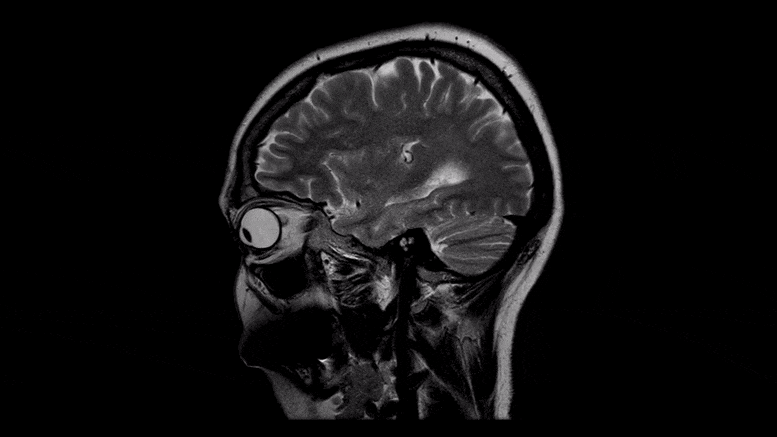
Computed tomography of the brain.
Patients with clinically diagnosed neurological symptoms associated with COVID-19 are six times more likely to die in the hospital than those without the neurological complications, according to an interim analysis from the Global Consortium Study of Neurologic Dysfunction in COVID-19 (GCS-NeuroCOVID).
A paper published today (May 11, 2021) in JAMA Network Open presents early results of the global effort to gather information about the incidence, severity, and outcomes of neurological manifestations of COVID-19 disease.
“Very early on in the pandemic, it became apparent that a good number of people who were sick enough to be hospitalized also develop neurological problems,” said lead author Sherry Chou, M.D., M.Sc., principal investigator of the consortium and associate professor of critical care medicine, neurology, and neurosurgery at the University of Pittsburgh School of Medicine and UPMC. “A year later, we are still fighting an unknown invisible enemy and, like in any battle, we need intel — we have to learn as much as we can about neurological impacts of COVID-19 in patients who are actively sick and in survivors.”

Principal investigator of the Global Consortium Study of Neurologic Dysfunction in COVID-19, associate professor of critical care medicine, neurology and neurosurgery, University of Pittsburgh School of Medicine and UPMC, and associate director of the Pitt Safar Center for Resuscitation Research. Credit: Sherry Chou
The GCS-NeuroCOVID is the largest cohort study of neurological manifestations of COVID-19 to date, spanning 133 adult patient sites in all continents except Antarctica.
Among one group of 3,744 hospitalized adult patients with COVID-19, 82% had self-reported or clinically captured neurological symptoms. Nearly 4 out of 10 patients reported having headaches, and approximately 3 out of 10 said they lost their sense of smell or taste. Of the clinically diagnosed syndromes — abnormalities that a bedside clinician can observe, regardless of whether the patient is aware of the problem — acute encephalopathy was most common, affecting nearly half of the patients, followed by coma (17%) and strokes (6%).
Despite early concerns about the coronavirus’s ability to directly attack the brain and cause brain swelling and inflammation — meningitis and encephalitis — those events were very rare, occurring in less than 1% of hospitalized COVID-19 patients.
“Acute encephalopathy is by far the most common symptom that we see in the clinic,” said Chou, also associate director of the Pitt Safar Center for Resuscitation Research. “Those patients may be in an altered sensory state or have impaired consciousness, or they don’t feel like themselves and act confused, delirious or agitated.”
The researchers analyzed data from three different types of patient cohorts — the “all COVID-19” cohort, which included all 3,055 hospitalized patients with COVID-19, irrespective of their neurological status; the “neurological” cohort, which included 475 hospitalized COVID-19 patients with clinically confirmed neurological symptoms compiled by the GCS-NeuroCOVID Consortium; and the “ENERGY” cohort, or 214 hospitalized COVID-19 patients who required evaluation by a consulting neurologist and provided consent to participate in the European Academy of Neurology Neuro-COVID Registry (ENERGY), a formal partner of the GCS-NeuroCOVID Consortium.
The study found that having a preexisting neurological condition of any kind — from brain, spinal cord, and nerve diseases to chronic migraines, dementia, or Alzheimer’s disease, among others — is the strongest predictor of developing COVID-19-related neurological complications, increasing the risk by two-fold. In addition, having any neurological symptoms related to COVID-19 — from something as seemingly innocuous as the loss of smell to major events like strokes — is associated with a six-fold higher risk of dying.
But even if a patient beats the odds and recovers, their long-term health outlook is still uncertain.
“Even if the pandemic is completely eradicated, we are still talking about millions of survivors who need our help,” said Chou. “It is important to find out what symptoms and health problems those patients are facing, and there is still plenty of work for years to come.”
Reference: 11 May 2021, JAMA Network Open.
DOI: 10.1001/jamanetworkopen.2021.12131
Additional authors of the study include Valeria Altamirano, M.S., of Pitt; Ettore Beghi, M.D., of Istituto di Ricerche Farmacologiche Mario Negri IRCCS, Milan, Italy; Raimund Helbok, M.D., of Medical University of Innsbruck, Austria; Elena Moro, M.D., Ph.D., of Grenoble Institute of Neuroscience, France; Joshua Sampson, Ph.D., of the National Cancer Institute, Baltimore; Shraddha Mainali, M.D., and Molly McNett, Ph.D., of The Ohio State University, Columbus, Ohio; Claudio Bassetti, M.D., of University of Bern, Switzerland; Jose Suarez, M.D., of the Johns Hopkins University School of Medicine, Baltimore; and other GCS-NeuroCOVID Consortium and ENERGY Consortium members. The GCS-NeuroCOVID consortium is endorsed by the Neurocritical Care Society.
Authors thank the research team at the Pitt School of Medicine, including the GCS-NeuroCOVID Consortium coordinator Ali Scott-Smith, volunteer Pitt neurology residents, Pitt medical students and undergrad students.
This research was supported by the National Institutes of Health (grant R21NS113037), National Center for Advancing Translational Sciences (grant UL1TR001857) and the University of Pittsburgh Dean’s Faculty Advancement Award.